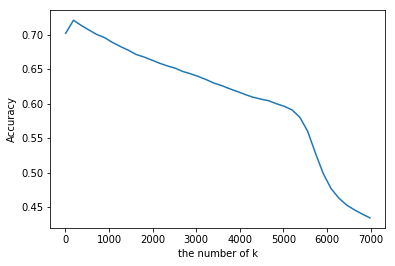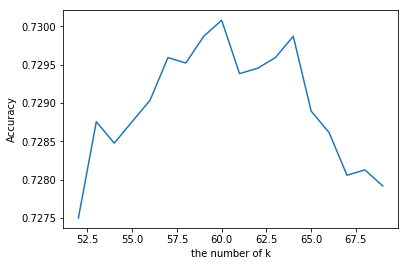9-1. 머신러닝으로 FIFA 19 선수 포지션 예측하기_1 [K-NN]
머신러닝으로 FIFA 19 선수 포지션 예측하기[K-NN]
import pandas as pd
import pickle
import matplotlib.pyplot as plt
import seaborn as sns
%matplotlib inline
문제 정의
FIFA 19의 선수 스텟을 바탕으로, 그 선수의 포지션을 예측하라
데이터 수집 및 전처리
# 데이터를 수집합니다
df = pd.read_csv("../data/fifa_data.csv")
# 수집된 데이터 샘플을 확인합니다
df.head()
| Unnamed: 0 | ID | Name | Age | Photo | Nationality | Flag | Overall | Potential | Club | ... | Composure | Marking | StandingTackle | SlidingTackle | GKDiving | GKHandling | GKKicking | GKPositioning | GKReflexes | Release Clause | |
|---|---|---|---|---|---|---|---|---|---|---|---|---|---|---|---|---|---|---|---|---|---|
| 0 | 0 | 158023 | L. Messi | 31 | https://cdn.sofifa.org/players/4/19/158023.png | Argentina | https://cdn.sofifa.org/flags/52.png | 94 | 94 | FC Barcelona | ... | 96.0 | 33.0 | 28.0 | 26.0 | 6.0 | 11.0 | 15.0 | 14.0 | 8.0 | €226.5M |
| 1 | 1 | 20801 | Cristiano Ronaldo | 33 | https://cdn.sofifa.org/players/4/19/20801.png | Portugal | https://cdn.sofifa.org/flags/38.png | 94 | 94 | Juventus | ... | 95.0 | 28.0 | 31.0 | 23.0 | 7.0 | 11.0 | 15.0 | 14.0 | 11.0 | €127.1M |
| 2 | 2 | 190871 | Neymar Jr | 26 | https://cdn.sofifa.org/players/4/19/190871.png | Brazil | https://cdn.sofifa.org/flags/54.png | 92 | 93 | Paris Saint-Germain | ... | 94.0 | 27.0 | 24.0 | 33.0 | 9.0 | 9.0 | 15.0 | 15.0 | 11.0 | €228.1M |
| 3 | 3 | 193080 | De Gea | 27 | https://cdn.sofifa.org/players/4/19/193080.png | Spain | https://cdn.sofifa.org/flags/45.png | 91 | 93 | Manchester United | ... | 68.0 | 15.0 | 21.0 | 13.0 | 90.0 | 85.0 | 87.0 | 88.0 | 94.0 | €138.6M |
| 4 | 4 | 192985 | K. De Bruyne | 27 | https://cdn.sofifa.org/players/4/19/192985.png | Belgium | https://cdn.sofifa.org/flags/7.png | 91 | 92 | Manchester City | ... | 88.0 | 68.0 | 58.0 | 51.0 | 15.0 | 13.0 | 5.0 | 10.0 | 13.0 | €196.4M |
5 rows × 89 columns
df1 = pd.DataFrame({'Name': df.Name,'Club':df.Club,'Position':df.Position,}) #선수정보데이터
df2 = df.iloc[:,54:88].astype(float) #스텟데이터
td = pd.concat([df1,df2],axis=1)
td
| Name | Club | Position | Crossing | Finishing | HeadingAccuracy | ShortPassing | Volleys | Dribbling | Curve | ... | Penalties | Composure | Marking | StandingTackle | SlidingTackle | GKDiving | GKHandling | GKKicking | GKPositioning | GKReflexes | |
|---|---|---|---|---|---|---|---|---|---|---|---|---|---|---|---|---|---|---|---|---|---|
| 0 | L. Messi | FC Barcelona | RF | 84.0 | 95.0 | 70.0 | 90.0 | 86.0 | 97.0 | 93.0 | ... | 75.0 | 96.0 | 33.0 | 28.0 | 26.0 | 6.0 | 11.0 | 15.0 | 14.0 | 8.0 |
| 1 | Cristiano Ronaldo | Juventus | ST | 84.0 | 94.0 | 89.0 | 81.0 | 87.0 | 88.0 | 81.0 | ... | 85.0 | 95.0 | 28.0 | 31.0 | 23.0 | 7.0 | 11.0 | 15.0 | 14.0 | 11.0 |
| 2 | Neymar Jr | Paris Saint-Germain | LW | 79.0 | 87.0 | 62.0 | 84.0 | 84.0 | 96.0 | 88.0 | ... | 81.0 | 94.0 | 27.0 | 24.0 | 33.0 | 9.0 | 9.0 | 15.0 | 15.0 | 11.0 |
| 3 | De Gea | Manchester United | GK | 17.0 | 13.0 | 21.0 | 50.0 | 13.0 | 18.0 | 21.0 | ... | 40.0 | 68.0 | 15.0 | 21.0 | 13.0 | 90.0 | 85.0 | 87.0 | 88.0 | 94.0 |
| 4 | K. De Bruyne | Manchester City | RCM | 93.0 | 82.0 | 55.0 | 92.0 | 82.0 | 86.0 | 85.0 | ... | 79.0 | 88.0 | 68.0 | 58.0 | 51.0 | 15.0 | 13.0 | 5.0 | 10.0 | 13.0 |
18207 rows × 37 columns
# 현재 가지고 있는 데이터에서, 포지션의 갯수를 확인한다
td.Position.value_counts()
ST 2152
GK 2025
CB 1778
CM 1394
LB 1322
RB 1291
RM 1124
LM 1095
CAM 958
CDM 948
RCB 662
LCB 648
LCM 395
RCM 391
LW 381
RW 370
RDM 248
LDM 243
LS 207
RS 203
RWB 87
LWB 78
CF 74
RAM 21
LAM 21
RF 16
LF 15
Name: Position, dtype: int64
- 비슷한 역할을 하는 포지션끼리는 합쳐서 포지션별 데이터의 수를 늘린다.
td.loc[td['Position']=='LF', ['Position']] = 'ST'
td.loc[td['Position']=='RF', ['Position']] = 'ST'
td.loc[td['Position']=='CF', ['Position']] = 'ST'
td.loc[td['Position']=='LS', ['Position']] = 'ST'
td.loc[td['Position']=='RS', ['Position']] = 'ST'
td.loc[td['Position']=='LAM', ['Position']] = 'CAM'
td.loc[td['Position']=='RAM', ['Position']] = 'CAM'
td.loc[td['Position']=='LCM', ['Position']] = 'CM'
td.loc[td['Position']=='RCM', ['Position']] = 'CM'
td.loc[td['Position']=='RDM', ['Position']] = 'CDM'
td.loc[td['Position']=='LDM', ['Position']] = 'CDM'
td.loc[td['Position']=='LW', ['Position']] = 'WF'
td.loc[td['Position']=='RW', ['Position']] = 'WF'
td.loc[td['Position']=='LB', ['Position']] = 'WB'
td.loc[td['Position']=='RB', ['Position']] = 'WB'
td.loc[td['Position']=='LWB', ['Position']] = 'WB'
td.loc[td['Position']=='RWB', ['Position']] = 'WB'
td.loc[td['Position']=='LM', ['Position']] = 'WM'
td.loc[td['Position']=='RM', ['Position']] = 'WM'
td.loc[td['Position']=='LCB', ['Position']] = 'CB'
td.loc[td['Position']=='RCB', ['Position']] = 'CB'
# 현재 가지고 있는 데이터에서, 포지션의 갯수를 확인한다
td.Position.value_counts()
CB 3088
WB 2778
ST 2667
WM 2219
CM 2180
GK 2025
CDM 1439
CAM 1000
WF 751
Name: Position, dtype: int64
td = td.dropna() #null값 제거
데이터 나누기 (학습 데이터, 테스트 데이터)
# sklearn의 train_test_split을 사용하면 라인 한줄로 손쉽게 데이터를 나눌 수 있다
from sklearn.model_selection import train_test_split
# 다듬어진 데이터에서 20%를 테스트 데이터로 분류합니다
train, test = train_test_split(td, test_size=0.2)
# 학습 데이터의 갯수를 확인합니다, 14565개의 데이터가 있습니다.
train.shape[0]
14334
# 테스트 데이터의 갯수를 확인합니다. 3642개의 데이터가 있습니다.
test.shape[0]
3584
다듬어진 데이터를 파일로 저장하기
다듬어진 데이터를 파일로 저장하여, 머신러닝 분류 알고리즘 실습 시에 사용하도록 하겠습니다.
with open('../data/fifa_train.pkl', 'wb') as train_data:
pickle.dump(train, train_data)
with open('../data/fifa_test.pkl', 'wb') as test_data:
pickle.dump(test, test_data)
데이터 불러오기 (학습 데이터, 테스트 데이터)
학습 데이터 및 테스트 데이터를 로드합니다.
with open('../data/fifa_train.pkl', 'rb') as train_data:
train = pickle.load(train_data)
with open('../data/fifa_test.pkl', 'rb') as test_data:
test = pickle.load(test_data)
최적의 k 찾기 (교차 검증 - cross validation)
# import kNN library
from sklearn.neighbors import KNeighborsClassifier
from sklearn.model_selection import cross_val_score
# find best k, range from 3 to half of the number of data
max_k_range = train.shape[0] // 2
k_list = []
for i in range(7, max_k_range, 179):
k_list.append(i)
cross_validation_scores = []
x_train = train.iloc[:,3:37]
y_train = train[['Position']]
# 10-fold cross validation
for k in k_list:
knn = KNeighborsClassifier(n_neighbors=k)
scores = cross_val_score(knn, x_train, y_train.values.ravel(), cv=10, scoring='accuracy')
cross_validation_scores.append(scores.mean())
cross_validation_scores
# visualize accuracy according to k
plt.plot(k_list, cross_validation_scores)
plt.xlabel('the number of k')
plt.ylabel('Accuracy')
plt.show()

# find best k
cvs = cross_validation_scores
k = k_list[cvs.index(max(cross_validation_scores))]
print("The best number of k : " + str(k) )
The best number of k : 186
- 범위를 좁혀서 다시시도한다.
# find best k, range from 3 to half of the number of data
k_list = []
for i in range(7, 367, 9):
k_list.append(i)
cross_validation_scores2 = []
x_train = train.iloc[:,3:37]
y_train = train[['Position']]
# 10-fold cross validation
for k in k_list:
knn = KNeighborsClassifier(n_neighbors=k)
scores = cross_val_score(knn, x_train, y_train.values.ravel(), cv=10, scoring='accuracy')
cross_validation_scores2.append(scores.mean())
cross_validation_scores2
# visualize accuracy according to k
plt.plot(k_list, cross_validation_scores2)
plt.xlabel('the number of k')
plt.ylabel('Accuracy')
plt.show()

# find best k
cvs2 = cross_validation_scores2
k = k_list[cvs2.index(max(cross_validation_scores2))]
print("The best number of k : " + str(k) )
The best number of k : 61
# find best k, range from 3 to half of the number of data
k_list = []
for i in range(52, 70):
k_list.append(i)
cross_validation_scores3 = []
x_train = train.iloc[:,3:37]
y_train = train[['Position']]
# 10-fold cross validation
for k in k_list:
knn = KNeighborsClassifier(n_neighbors=k)
scores = cross_val_score(knn, x_train, y_train.values.ravel(), cv=10, scoring='accuracy')
cross_validation_scores3.append(scores.mean())
cross_validation_scores3
# visualize accuracy according to k
plt.plot(k_list, cross_validation_scores3)
plt.xlabel('the number of k')
plt.ylabel('Accuracy')
plt.show()

# find best k
cvs3 = cross_validation_scores3
k = k_list[cvs3.index(max(cross_validation_scores3))]
print("The best number of k : " + str(k) )
The best number of k : 60
- 최적의 k는 60이다.
모델 테스트
# import libraries
from sklearn.neighbors import KNeighborsClassifier
from sklearn.metrics import accuracy_score
knn = KNeighborsClassifier(n_neighbors=k)
# select data features
x_train = train.iloc[:,3:37]
# select target value
y_train = train[['Position']]
# setup knn using train data
knn.fit(x_train, y_train.values.ravel())
# select data feature to be used for prediction
x_test = test.iloc[:,3:37]
# select target value
y_test = test[['Position']]
# test
pred = knn.predict(x_test)
# check ground_truth with knn prediction
comparison = pd.DataFrame(
{'prediction':pred, 'ground_truth':y_test.values.ravel()})
comparison
| prediction | ground_truth | |
|---|---|---|
| 0 | WM | CAM |
| 1 | CM | WB |
| 2 | ST | WM |
| 3 | WB | WM |
| 4 | CDM | CDM |
| 5 | CDM | CB |
| 6 | WM | CAM |
| 7 | CB | CB |
| 8 | WB | WB |
| 9 | GK | GK |
| 10 | GK | GK |
3584 rows × 2 columns
# check accuracy
print("accuracy : "+
str(accuracy_score(y_test.values.ravel(), pred)) )
accuracy : 0.7279575892857143